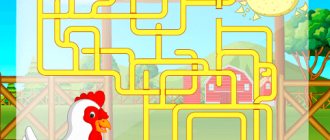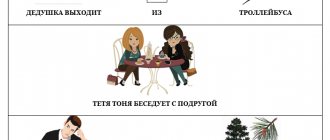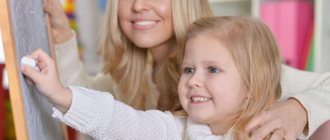Didactic material for express examination of sound pronunciation
DIDACTIC MATERIAL EXPRESS SURVEY OF SOUND PRONUNCIATION IN SENIOR PRESCHOOL CHILDREN
To enroll in a speech therapy center, the speech therapist teacher must conduct a rapid examination of the entire group. Children with FFDD are enrolled in the speech therapy center. FFNR is caused primarily by a violation of sound pronunciation. Therefore, the speech therapist must have material for prompt mass examination of children in order to identify those in need of speech therapy help.
There is a manual by the country's leading speech therapists. Konovalenko V.V. and Konovalenko S.V. "Rapid examination of sound pronunciation in children of preschool and primary school age." In my opinion, it is no different in scope from the manuals recommended for in-depth examination of children.
That's why. I developed and developed speech material for an express examination of the pronunciation of sounds for preschool children.
The structure of the express examination for each sound is as follows:
First, we check the sound pronunciation in sentences rich in a given sound. Tongue twisters and sentences of complex and simple structure are used here.
If the child pronounces correctly, you can additionally check in his own speech. To do this, ask them to come up with suggestions based on the pictures. Based on the sentences compiled, it will be possible to judge how well the grammatical categories are formed. If it turns out that there is no understanding of grammatical forms (singular and plural nouns, feminine and masculine forms, incorrect use of cases), then you can continue working on the pictures: offer to name objects in singular. and in plural including, first name feminine objects, then masculine ones, etc.
Then move on to checking another sound.
If a defect is detected, continue the examination in the pronunciation of words of different syllable structures. It is advisable for the child to name the objects (objects) in the pictures. The words are selected taking into account the sequence in accordance with the main groups/classes of the syllabic structure of words.
And as a result, the isolated pronunciation of the sound is checked, as well as in forward and backward syllables, in syllables with a confluence.
This teaching material is printed on photographic paper, placed in a folder with files for 20 pieces. I always carry it with me. Very comfortably. When examining, I simply turn the pages.
I would appreciate your feedback.
EXPRESS EXAMINATION OF THE STATE OF SOUND PRONUNCIATION IN CHILDREN 5 -7 years old
(Whistling sounds. Sounds S - S)
1.Repeat:
Little Sanya's sleigh moves on its own. There is a tall pine tree in the forest.
Little Sanya drives the sleigh on its own. Sonya bought juice.
2. Name and repeat: Beads - dog - soup - forest - sock - scooter - table - masks - shepherd - bench
3. Repeat: S-S-S-S-S sa – so – su – sy; as – os – us – ys;
ska - sko - hundred - stu - sleep - dreams - spa - sleep;
4. Repeat:
Senya is carrying hay in the canopy
,
Don't be afraid - it's a goose, Plums are hanging on a branch.
Senya will sleep on the hay. I'm afraid of him myself. Vasya is herding geese.
5. Name - repeat: Sieve - fox cubs - seven - goose - autumn - cornflower - snow - plums - traffic light
6. Repeat:
sya – syo – syu – si; as - axis - us;
slya - sli - laugh - stya - shame - sti - sleeping - sleep - sleep - all - all - all;
EXPRESS EXAMINATION OF THE STATE OF SOUND PRONUNCIATION IN CHILDREN 5 -7 years old
(Whistling sounds. Sounds З - Зь)
1. Repeat:
Zoya is the bunny's mistress, Zoya has a mimosa. Zoya puts a mimosa in a vase.
The bunny is sleeping in Zoya's basin.
2. Name - repeat: Goat - alphabet - tooth - cart - fence - name - umbrella - nest - Dunno
3. Repeat: Z-Z-Z-Z for - zo - zu - zy; az – oz – uz – yz; zva – zvo – zda – zdo – zna – zna;
4. Name it - repeat: My little goat has green eyes. A goat gnaws on green cabbage.
In winter, Zina's nose gets cold. Kuzya goes to the museum.
5. Name - repeat: Winter - newspaper - goat - shop - snake - grain - monkey - strawberry
3. Repeat: zy - ze - zy - zi; azi – oz – uz – iz;
zve – zvi – zve; I know - I know - I know - I know; serpent - serpent;
EXPRESS EXAMINATION OF THE STATE OF SOUND PRONUNCIATION IN CHILDREN 5 -7 years old
(Whistling sounds. Sound Ts)
1.Repeat: From the neighboring well Chicken and hen The hare sits under an acacia bush.
Water flows all day long. They drink water on the street. There is water in the well.
2. Name - repeat: Face - chicken - chain - hare - well - saucer - flower - towel
3. Repeat: Ts-Ts-Ts-Ts-Ts ats - ots - uts - ets - its; tsa - tso - tsy - tse; tsva - tsve - tsvi;
EXPRESS EXAMINATION OF THE STATE OF SOUND PRONUNCIATION IN CHILDREN 5 -7 years old
(Hissing sounds. Sh sound)
1.Repeat: Hush, mice, don’t make noise, Masha sewed for the monkey, Dasha washes her neck and ears in the shower.
Don't wake our cat. A fur coat, a hat and pants. The mouse has a hat.
2. Name - repeat: Porridge - reeds - jester - shower - bag - cockerel - closet - cherry - grandmother - sunshine
3. Repeat: Sh-Sh-Sh-Sh-Sh sha - sho - shu - shi - she; ash - osh - ush - ish - ysh; shka - shko - shku
(Hissing sounds. Sound F)
4. Repeat: The beetle has fallen and cannot fly. Without sparing its legs, the hedgehog runs.
He is waiting for someone to help him. The hedgehog has a hedgehog.
5. Name - repeat: Skis - greedy - beetle - hedgehog - pie - spoon - scissors - skier - snowdrop
6. repeat: Zh-Zh-Zh-Zzha - zho - zhu - zhi - zhe; waiting - waiting - waiting; zhna - zhno - zhnu - zhzhny;
(Hissing sounds. Sound Ch)
7. Repeat: Water, water, wash my face. Tanya is swinging on a swing. The girl bakes cookies.
8. Name - repeat: Clock - swing - tea - ball - rich man - candle - barrel - cookies - Snow Maiden
9. Repeat: Ch-Ch-Ch-Ch-Ch ach - och - uch - ich; cha - che - chu - chi;
chnya - chne - chnyu - chni; honor - honor - honor;
(Hissing sounds. Shch sound)
10. Repeat: I drag the pike, I drag it, The puppy squeaks in the gorge. Children are looking for a puppy.
I won't miss the pike.
11. Name - repeat: Pike - shield - cape - puppy - pliers - brush - click - glazier - traffic controller
12. Repeat: sch-sch-sch-sch - sch sch - sch - sch - sch; sha - schu - schu - cabbage soup;
schnya - schnyu - schni; vscha – vschu – vschi;
EXPRESS EXAMINATION OF THE STATE OF SOUND PRONUNCIATION IN CHILDREN 5 -7 years old
(Sonoras: Р – Рь)
1.Repeat: A mole climbed into our yard, Vera and Roma are drumming on a drum.
Digging the ground at the gate. There are carps in the pond.
2. Name - repeat: Feather - cow - cancer - ball - ram - tomato - pipe - watermelon - tram - grapes
3. Repeat: R-R-R-R-R ra - ro - ru - ry; ar - or - ur - yr; tra - tro - tru - tra; sconce - bro - bru;
4. Repeat: At my sister Marina’s, Rita and Varya are making jam.
Cheeks like tangerines. Marina is cooking rice.
5. Name - repeat: Turnip - rowan - lantern - cucumber - mushrooms - tourist - backpack - mittens - apricots
6. Repeat: rya - re - ryu - ri; ar - or - ur - yr; quack - cre - cru - cree; three - three - three;
(Sonoras: L - L)
7. Repeat: A young elk ran through golden straw. Mila was washing the floor in the classroom. Alla was eating an apple.
8. Name - repeat: Soap - milk - onion - pencil case - table - wolf - squirrel - lightning - flower bed - needle
9. Repeat: L-L-L-L-L al - ol - ul - yl; la - lo - lu - ly;
kla - klo - klu - slu - slo - sly - plo - ply - gla - glo - glu;
10. Repeat: They stomped and stomped, they stomped until they reached the poplar, Luda watered the tulips from a watering can.
They stomped all the way to the poplar, but their feet stomped. Lena has a green ribbon.
11. Name - repeat: Log - lion - lemon - vacuum cleaner - watering can - frog - snail - refrigerator
12. Repeat: la - le - lyu - li; al - ol - ul - il; for - for - for - for; vlya - slyo - angry - pli;
Logomag
DIAGNOSTIC DIRECTION OF WORK OF A Speech Pathologist TEACHER AT THE LEVEL OF BASIC GENERAL EDUCATION
Kiseleva Natalya Yurievna, Ph.D. n. ( [email protected] )
Institute of Special Education and Complex Rehabilitation of the State Autonomous Educational Institution of Higher Education of the City of Moscow "Moscow City Pedagogical University" (ISOiKR State Autonomous Educational Institution of Higher Education MSPU)
Output:
Kiseleva N.Yu. Diagnostic direction of work of a speech therapist at the level of basic general education. / Theory, history and methodology of psychological and pedagogical support for children with special educational needs Proceedings of the VIII international theoretical and methodological seminar on March 14, 2016, Moscow, Volume 2. - M.: Paradigma, 2016. - P. 203 - 209.
Our country is modernizing its education system. The number of students with disabilities who come to study in general education organizations is increasing. The Federal Law “On Education in the Russian Federation” (2012), Federal State Educational Standards LLC provide a regulatory framework for teaching children with disabilities at the level of basic general education. It should be noted that among students with disabilities studying the basic general education program, a special group consists of children with speech impairments. When studying under conditions of integration and inclusion, these students experience certain difficulties in mastering the program and achieving the results determined by the Federal State Educational Standard, which is associated with difficulties in mastering written and speech activities (T.A. Altukhova, R.I. Lalaeva, R.E. Levina , E.N. Rossiyskaya, M.N. Rusetskaya, G.V. Chirkina, etc.). In accordance with this, the issues of organizing and conducting diagnostic work of a speech therapist at the level of basic general education become relevant.
The diagnostic direction of work of a speech therapist teacher at the level of basic general education includes the study and analysis of medical and pedagogical documentation, examination of the speech of students in grades 5-9, observation of students in educational and extracurricular activities, discussion and analysis of the activities and psychological characteristics of children with teachers of general education organizations and parents.
The examination of student speech is carried out at the beginning of the school year (September 1-15) and at the end of the school year (May 15-31). Data on the results of the examination are entered into the “Speech Card”, which should contain the following sections: general data; study of oral and written speech; conclusion about the state of oral and written speech.
Common data.
1. Personal information.
2. General anamnesis.
3. Data on early speech development.
4. Data on the results of speech therapy work in preschool and primary school age.
Study of oral and written speech.
5. Formation of functional prerequisites for written and speech activity.
6. Oral speech.
7. Letter
8. Reading.
9. Written speech.
Conclusion about the state of oral and written speech.
10. Speech therapy report.
11. Main directions of individual pedagogical strategy.
Let us dwell in more detail on the section “Studying oral and written speech.” Formation of functional prerequisites for written and speech activity. Diagnostic parameters: motivation for written and speech activities; visual and auditory attention; visual and auditory memory; auditory-motor coordination; verbal-logical thinking; programming, regulation and control of activities; operations of language analysis and synthesis; grammatical operations. When preparing assignments, you can use the manuals of Anufriev A.F. and Kostromina S.N. (1997), Galperina P.Ya. and Kabylnitskaya S.L. (1974), Semago M.M. (2005), Tigranova L.I. (2005).
Oral speech.
The examination includes a diagnostic conversation (dialogue speech), retelling or story (monologue speech), performing lexical and grammatical tasks, studying the state of sound pronunciation. During the examination, the speech therapist notes the general characteristics of the sound of speech: pace and rhythm, intelligibility, strength of sound, expressiveness. The examination of oral speech should be supplemented by observations of spontaneous speech of students in educational and extracurricular activities. A speech therapist teacher can attend and observe individual lessons taught by subject teachers or speech pathologists, which will allow a more complete study of the speech and communication characteristics of students.
Examination of the letter.
To study students’ writing, the teacher-speech therapist analyzes the material from workbooks and test books in the Russian language; Conducts dictation and copying with students. Then a quantitative and qualitative analysis of spelling and specific errors, grapho-motor difficulties of students is carried out.
This examination can be supplemented by an analysis of the material from workbooks and outline maps in the academic disciplines studied by students in order to identify visual-spatial impairments and the success of using sign-symbolic means in writing.
Reading survey.
The survey material consists of texts of different styles (fiction, journalistic, scientific, official business style) and a set of tasks for them. Diagnostic texts for reading must meet certain requirements: the text volume is no more than two pages; font Times New Roman or Bookman Old Style, font size 14 points, line spacing – one and a half.
Students are asked to read two texts aloud and two texts “to themselves.” The examination procedure involves reading the entire text to the end, which makes it possible to subsequently complete tasks for the text and study the semantic characteristics of reading.
Here are the reading diagnostic parameters: the technical side of reading (method of reading aloud, level of silent reading, correctness of reading aloud, speed of reading aloud, speed of reading “silently”); expressiveness; semantic side of reading (answers to questions of different types, structural and semantic analysis of the text, retelling).
As is known, the method of reading aloud is determined in accordance with the stages of mastering this skill: letter-by-letter, syllabic, syllabic with synthetic elements, synthetic reading (T.G. Egorov). Students mastering the basic general education program should have a synthetic reading method. Syllabic or syllabic with elements of synthetic reading methods indicate a violation of this component.
Reading accuracy is assessed by the number of errors a student makes when reading 100 words. When assessing the correctness of reading, the number and nature of errors made are analyzed. The following types of errors are taken into account: guessing reading errors; distortions of the sound-syllable structure of words (omission of letters, syllables, perseveration, anticipation, reversal of letters); mixing letters based on acoustic-articulatory and optical similarity; errors in stress placement; agrammatism; errors in intonation marking sentence boundaries; violation of spelling norms when reading; omissions and repetitions of words; skipping and repeating lines. According to our research, the main mistake among students in grades 5-9 is reading by guess - errors in the endings of words, substitution of words based on optical or semantic similarity (Kiseleva N.Yu., 2013). Apparently, in the described age group, in response to the rather high requirements for reading speed that schools impose, the role of semantic guesswork in reading increases. However, the insufficient level of language competence in children with speech disorders does not always allow them to guess the context accurately.
Text reading speed is determined by the number of words read in one minute. For students in grades 5-9, quantitative indicators of reading speed are not indicated in the program. According to our research, reading aloud speed indicators for 5th grade students below 83 words per minute, for 6th grade students below 105 words per minute, for 7th grade students below 111 words per minute are assessed as a violation of this component of reading [3, p.69] . It should be noted that the assessment of this component of reading in students with disabilities and speech impairments should be approached individually, taking into account the personal characteristics of the child.
The stages of reading “to oneself”: “buzzing reading”, quiet whispering reading, reading with silent articulation, silent reading, automated reading “to oneself” were determined by Yu.A. Guziy. “Reading “to oneself” at the initial stage of learning for a student is a more complex activity, building on top of the structural components of reading aloud that have already been formed by this moment, which, having reached a high level of automation, begin to collapse” [2]. When diagnosing, you should pay attention to the difference between the speed of reading aloud and silently. According to our research, this difference is 14-20 words for students in grades 5-7 with dyslexia and 31-37 words for students with normally developed reading (Kiseleva N.Yu., 2013). Note that after reading the text “to yourself” it is also necessary to check your understanding of what you read.
Expressiveness of reading is an indicator that integrates the levels of mastery of the technical and semantic aspects of reading (Egorov T.G., Rusetskaya M.N., Elkonin D.B., etc.). When assessing expressiveness, attention is paid to loudness, intelligibility, correct use of pauses, logical and psychological stress, use of correct intonation in accordance with final punctuation marks and the syntactic structure of the text.
The semantic side of reading aloud and “to oneself” realizes the main purpose of the reading process - understanding the text, the ability to extract certain information from it, and determining the author’s intention. Identifying the formation of conscious, semantic reading, as a universal educational action, helps to predict the student’s readiness to work with information, the success of mastering the personal, meta-subject and subject requirements of the program, defined by the Federal State Educational Standard of LLC. The specificity of impaired reading activity of students with speech impairments at the level of basic general education is that the dominant component in the structure of reading impairment is a violation of its semantic side [3].
Examination of written language.
L.S. Vygotsky was the first to divide the concepts of “writing” as a technique for recording oral speech using graphic signs and “written speech” as a process of “written expression of one’s thoughts” [1, p. 57].
To study independent written speech, the teacher-speech therapist analyzes creative dictations, presentations and essays of students written in a Russian language or literature lesson; and also gives a diagnostic task - to write a statement and an essay. This independent written work is performed by students without the help of a speech therapist teacher and without preliminary oral compilation of a story.
Here are the parameters for diagnosing independent written texts: compliance of the content with the given topic; compositional structure; integrity (volume, reliability, consistency of presentation); stylistic correspondence (style, use of language); compliance with the norms of literate speech (spelling errors, specific errors) [4, 5].
Note that, in contrast to the diagnostic work carried out by a speech therapist at the level of primary general education, the examination of the speech of students in grades 5-9 has certain specifics, which is due to the structural and functional characteristics of written and speech activity and the age of the students. When studying speech, the speech therapist teacher, first of all, conducts an examination of reading, written speech and sound pronunciation. If the study of these complex categories does not reveal any violations, then the examination of the formation of the remaining components of oral speech, as well as the functional prerequisites for written speech and writing, may not be carried out.
After the examination, the speech therapist teacher provides information about the speech characteristics of children with disabilities and makes recommendations to subject teachers, specialists from general education organizations and parents. Thus, while implementing the diagnostic direction of work, the speech therapist interacts with all participants in the educational process.
Based on the results of the student’s examination, the teacher-speech therapist can refer him to a specialized center or to a psychological, medical, and pedagogical commission for additional diagnostics and clarification of the conclusion.
Implementation of the diagnostic direction of work as a speech therapist teacher at the level of basic general education allows:
• identify a group of students who need correctional and pedagogical assistance;
• identify the individual difficulties of each child;
• determine the content of correctional and developmental, advisory and informational and educational areas of work;
• monitor the success of correctional work during the school year.
Literature
1. Vygotsky L.S. Prehistory of the development of written speech / L.S. Vygotsky // Studies of reading and literacy at the Psychological Institute for 100 years: Reader, ed. N.L. Karpova, G.G. Granik, M.K. Kabardova - M.: Russian School Library Association, 2013. - P. 39-58.
2. Guziy Yu.A. Disturbances in the formation of reading “to oneself” and their correction in students of junior grades of secondary schools: abstract of thesis. dis. ...cand. ped. Sciences / Yu.A. Guziy. – M.: 2007. – 26 p.
3. Kiseleva N.Yu. Speech therapy work on the formation of reading competencies in students with dyslexia in primary school: dissertation ... Ph.D. ped. Sciences: 13.00.03 / N.Yu. Kiseleva. – M.: 2013. – 225 p.
4. Russian E.N. Methodology for the formation of independent written speech in children / E.N. Russian. – M.: Iris-press, 2005. – 240 p.
5. Elkonin D.B. Development of oral and written speech of students / D.B. Elkonin // Ed. V. V. Davydova, T. A. Nezhnova. - M.: INTOR, 1998. - 112 p.







